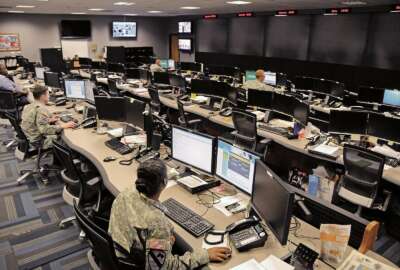

The Army and Navy both said on Thursday that their contributions to U.S. Cyber Command's Cyber Mission Force had achieved full operational capability, a year ahead...
The Army and Navy both announced Thursday that their respective shares of the offensive and defensive cyber teams the Defense Department has spent the last several years constructing are now fully up and running, about a year ahead of the schedule set by U.S. Cyber Command.
CYBERCOM, which has overall authority over the 133 teams the military services are building, certified that the Army’s 41 teams of active-duty soldiers and civilians had reached full operational capability (FOC) on Sept. 28. A similar validation for the Navy’s 40 teams followed on Oct. 6, officials said.
In both cases, the declarations mean that the teams are fully staffed, trained and equipped to meet the missions DoD initially laid out for what’s collectively known as the Cyber Mission Force when it assigned the services to begin building the teams in 2013.
Each of the services is expected to have its teams achieve the FOC stage by Sept. 30, 2018, and each declared initial operating capability (IOC) in October of last year.
“Reaching FOC at this point in the development of the Navy’s CMF teams is a testament to the extraordinary hard work invested in manning our teams and training our personnel,” Vice Adm. Michael Gilday, the commander of the Navy’s 10th Fleet/Fleet Cyber Command, said in a statement.
But he cautioned that the FOC declaration — coming after 1,800 personnel had completed some 18,000 courses — does not mean the Navy has come close to meeting all of its objectives when it comes to equipping and training its cyber workforce, and is not a measure of overall “combat readiness.”
“Although reaching this milestone is a great accomplishment, the true challenge will be sustaining readiness and the prompt ability to ‘answer all bells’ when directed by U.S. Cyber Command,” he said.
Lt. Gen. Paul Nakasone, the commanding general of Army Cyber Command, struck a similar tone, saying that although the ahead-of-schedule FOC declaration was evidence of the high priority defense leaders had placed on building cyber capabilities, the U.S. Cyber Command certification signaled more of a beginning than the accomplishment of an end state.
“The Army’s cyber teams are built and fully operational, but our work is just beginning, as we ensure they stay trained and ready to step into the joint fight when needed,” he said.
Indeed, the Army is still working to recruit and train members of another 21 teams in its National Guard and Reserve components. Training for those team members is likely to take until at least 2019.
Brig. Gen. Stephen Hager, an Army reservist who currently serves as the deputy commander for operations for U.S. Cyber Command’s National Mission Force, said the long-term plan is to let reserve component soldiers perform many of their cyber missions from wherever they happen to live, but for now, the Guard and Reserve’s concentration areas for cyber teams are highly “East Coast-centric.”
“What I would do is I would erase the map of where the active-duty bases are,” he said last month at the Association of the U.S. Army’s annual conference in Washington. “We need to diversify our workforce. Where is the tech sector growing for IT and cyber skillsets? I want to go to that target-rich environment. People with civilian skills are going to jump around from company to company, but they’re probably going to stay in that close geographical area. For the reserve forces, I would look at how we can position ourselves better in the next five-to-10 years to be additive to what active-duty has and not to be replicate of what they have.”
Copyright © 2025 Federal News Network. All rights reserved. This website is not intended for users located within the European Economic Area.
Jared Serbu is deputy editor of Federal News Network and reports on the Defense Department’s contracting, legislative, workforce and IT issues.
Follow @jserbuWFED

